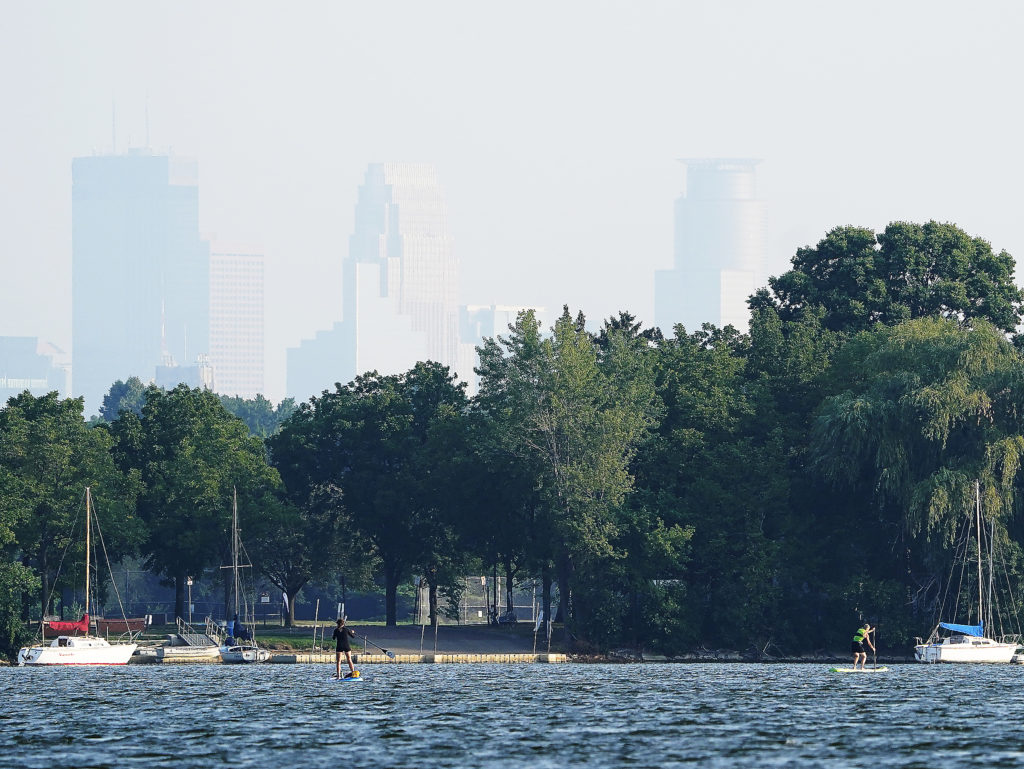Minnesotans are starting to see and breathe the effects of climate change as wildfires in the western United States, southern Canada and now northern Minnesota make air quality and agriculture deteriorate within the state.
Thomas Kozlovsky
In late July, smog filled the Twin Cities skies. The Minnesota Pollution Control Agency called it an unprecedented stretch of bad air quality coming from the steady forest fires in British Columbia. It became difficult to breathe, particularly for at-risk groups.
Minnesota residents have started to see the residual effects of climate change on people’s health and agriculture with the increase of wildfires in the western U.S. and southern Canada. Over time, these effects could worsen, ranging from heart attacks and fatal respiratory illnesses to declines in mental health and work productivity.
“I was giving tours at the visit office at the U and visibility was smoggy and weird. Giving tours was difficult in those days because families and myself were getting out of breath easily,” Kay Rusch, a senior student and tour guide at the University of Minnesota, said of July 2021.
The rise in wildfires can be attributed to changing weather patterns that cause longer and more serious droughts, according to Lee Frelich, the director of forest ecology at the University of Minnesota. Combined with drier forests and stronger winds, Minnesota will become more susceptible to fires.
“All the analysis of future wildfires occurrence put Minnesota in a ‘red zone’ for very large increases in forest fires, especially in northern Minnesota,” Frelich said. “It’s a complex story, but we should expect big, high intensity fires like in Canada and northern Minnesota.”
Dr. Bruce Alexander, professor and division head of environmental health sciences at the University of Minnesota, said everyone will feel the effect, regardless of whether they are immunocompromised.
“Pollution doesn’t respect boundaries,” Alexander said.

Despite the fear that air pollution will become a bigger problem as wildfires continue to grow in magnitude over the coming decades, there is hope that Minnesotans can help reduce the number of wildfires in the state.
“Air pollution comes from people, mostly,” Alexander said. “There’s a lot people can be doing to take inventory of how they are contributing, how much they’re driving, how much they are using excess energy.”
Some ways to minimize your own carbon footprint include: eating less meat, using less energy and water at home and taking public transportation or walking rather than driving a car.
“I think most of [climate change] is preventable, which is frustrating. If we can do something about it like riding a bike instead of driving, we should,” Katie Cardell, a senior at the University of Minnesota, said. “I think some of the draw to Minneapolis and Minnesota is the outdoor space and Boundary Waters which will get a lot less attractive if there is smog everywhere and the trees burn down and the rivers are black.”
Eating less meat may be the most effective way to reduce your environmental impact, according to Frelich, as animal agriculture is responsible for large amounts of deforestation and carbon emission.
“Going to a plant-based diet is the biggest thing any individual can do,” Frelich said.
These fires have a long-term potential of drastically reshaping Minnesota’s agriculture. In Minnesota, agriculture can be split into two groups: forestry and farmland. The story, according to Frelich, is different for those two agriculture groups.
“For agriculture like corn and farming it’s more a matter of developing varieties that are heat tolerant or growing new crops that grow in warmer areas,” Frelich said. “There would be a lot of adaptation and a lot of problems because of likely droughts in the middle of summer. That is not a good scenario for farmers.”
Even with cutbacks to carbon dioxide emissions, wildfires are still going to be a reality in Minnesota. “We’re not going to stop these fires, but we can mitigate their impact,” Frelich said. “You can’t suppress them. They explode and they grow very fast especially in a dry forest which we have a lot of now in Minnesota.”
With these likely negative effects to agriculture coming to Minnesota, it is important to see how hotshot firefighters handle these fires and why they are so hard to control.
“The main ways I have seen the firefighting industry attempt to prevent wildfires is by education about forest health, wildfire prevention and wildfire suppression.”
Hannah Goldman
Hotshot firefighters deal with wildfires on the front lines every summer and fall. There is normally no stopping the larger fires. The only option is containing them.
“Low intensity fires are often easier and safer to contain for firefighters. I have also worked on many fires that are larger, faster moving and more intense and destructive. These are the fires that seem to reach the press and large news outlets,” Goldman said. “These fires often pose more challenges for firefighters to safely contain and stop these fires getting larger.”
“Climate change is a growing issue and for me it’s a bigger issue for what world we are leaving behind for the people who come after us,” Rusch said. “If we don’t do anything the situation will keep getting worse and then people will have to deal with [climate change’s] effects more often than just a couple days out of the year.”